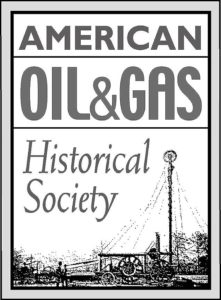Oil and natural gas industry infrastructure: Moving from a 42-gallon oil barrel to kerosene-fueled rockets.
Pipelines replaced the teamsters who moved the first wooden oil barrels to kerosene refineries decades before the internal combustion engine. Oil transportation networks have been part of daily life since America’s first oil well in August 1859. The industry’s infrastructure (vital for making petroleum products) evolved from the 19th century standard 42-gallon barrel, wooden oil tanks, iron pipelines, autos and diesel-electric trains, to modern jet aircraft and kerosene-fueled rockets.
Adding Wings to the Iron Horse
By the early 1930s, America’s passenger railroad business was in deep trouble. In addition to the Great Depression, the once dominant transportation industry faced growing competition from automobiles.
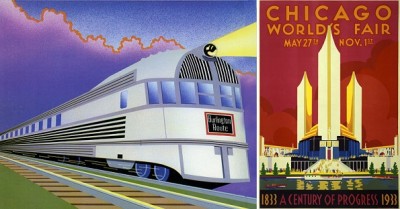
Powered by an eight-cylinder Winton 201A diesel engine, the revolutionary “streamliner” traveled the 1,015 miles from Denver to Chicago in just over 13 hours — a passenger train record.
New U.S. refineries produced vast amounts of gasoline, thanks to giant oilfield discoveries. Primitive diesel engines of the day remained heavy and slow. The railroad diesel-electric engine was in the future.
America exports Oil
A U.S. brig shipped hundreds of barrels of petroleum from Philadelphia to London during the Civil War. In early January 1862, the Elizabeth Watts arrived at London’s Victoria dock after a six-week voyage from Philadelphia. The brig carried 901 barrels of oil and 428 barrels of kerosene from Pennsylvania oilfields. It was the first time America exported oil.
America on the Move
The National Museum of American History in Washington, D.C., has educated millions of visitors about America’s transportation history since “America on the Move” opened on the first floor in November 2003.
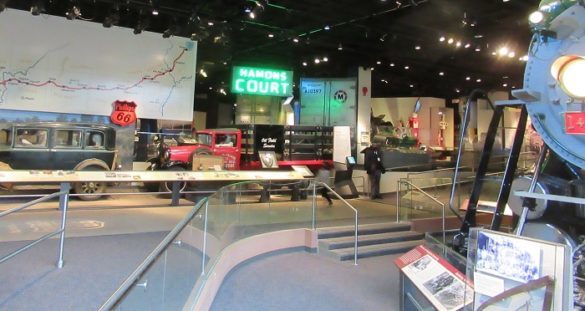
An exhibit about the history of Route 66 — commissioned in 1926 and fully paved by the late 1930s — is part of the Transportation Hall at the National Museum of American History.
Exhibits include a 1931 red Ford truck representing oilfield service companies from Shawnee, Oklahoma.
Cantankerous Combustion – 1st U.S. Auto Show
The first U.S. Auto show opened in New York City’s Madison Square Garden in 1900, just five years after Charles Duryea claimed the first American patent for a gasoline-powered automobile. Gas proved to be the least popular source of engine power.
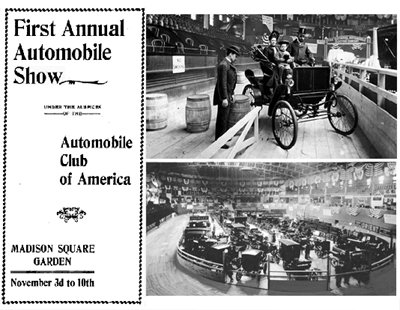
Automobiles powered by internal combustion engines at the 1900 National Automobile Show were primitive. The most popular models proved to be electric, steam, and gasoline…in that order.
On November 3, 1900, America’s first automobile show presented an innovative assortment of electric, steam, and “internal explosion” engines to power horseless carriages. Manufactures like Olds Motor Works of Lansing, Michigan, introduced models — one of each kind — to compete in the developing market.
Densmore Oil Tank Cars
As Northwestern Pennsylvania oil production skyrocketed following the Civil War, railroad oil tank cars fabricated by two brothers improved shipment volumes from oilfields to kerosene refineries. The tank car designed by James and Amos Densmore would not last long, but more success followed when Amos came up with an innovative keyboard arrangement for typewriters.
Dome Gas Station at Takoma Park
Picturing history: Images in the Library of Congress digital collection offer rare insights into the early U.S. petroleum industry. One 1921 black-and-white photo from a Washington, D.C., suburb captures a scene of petroleum products and transportation infrastructure. Originally printed from an eight-inch by six-inch glass negative, the gas station image features Takoma Park, Maryland, and its railroad station.
Exxon Valdez Oil Spill
“No one anticipated any unusual problems as the Exxon Valdez left the Alyeska Pipeline Terminal at 9:12 p.m., Alaska Standard Time,” reported the Alaska Oil Spill Commission about the March 24, 1989, offshore disaster.
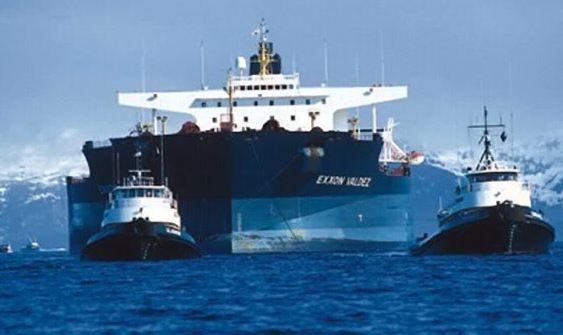
Field studies continue to examine the effects of the Exxon supertanker’s disastrous grounding on Bligh Reef in Alaska’s Prince William Sound in 1989. Photo courtesy Erik Hill, Anchorage Daily News.
Shortly after midnight, the 987-foot tanker hit Bligh Reef and spilled more than 260,000 barrels of oil, affecting hundreds of miles of coastline. “The system designed to carry two million barrels of North Slope oil to West Coast and Gulf Coast markets daily had worked perhaps too well,” noted the commission’s initial report.
First Car, First Road Trip
On January 29, 1886, German mechanical engineer Karl Friedrich Benz applied for an Imperial patent for his three-wheeled carriage powered by a one-cylinder, four-stroke gasoline engine. Two years later, his wife Bertha became the first person to drive her husband’s “motorwagen” over a long distance; her publicity stunt brought wide attention…and sales.
First Gas Pump and Service Station
Service stations gasoline pumps began in the 1880s as a device for dispensing kerosene at a grocery store. S.F. (Sylvanus Freelove) Bowser sold his newly invented kerosene pump to the owner of a grocery store in Fort Wayne, Indiana, on September 5, 1885. Less than two decades later, the first purposely built drive-in gasoline service station opened in Pittsburgh, Pennsylvania.

Gas pumps with dials were followed by calibrated glass cylinders. Meter pumps using a small glass dome with a turbine inside replaced the measuring cylinder as pumps continued to evolve. Illustration courtesy Popular Science, September 1955.
Bowser designed a simple device for reliably measuring and dispensing kerosene — a product in high demand as lamp fuel for half a century. His invention soon evolved into the metered gasoline pump.
Flight of the Woolaroc
Four days after Charles Lindbergh’s famous transatlantic flight in May 1927, James Dole of the Dole Pineapple Company offered a $25,000 first prize for an air race of its own – across the Pacific from Oakland to Honolulu, Hawaii. Thanks to Frank Phillips, high-octane gas refined by Phillips Petroleum Company powered the “Woolaroc” monoplane to victory in a record-setting but deadly 1927 air race from California to Hawaii.
History of the 42-Gallon Oil Barrel
With 19th century coopers making wooden barrels of all capacities — including hogsheads, puncheons, tierces, butts, and tuns — a group of America’s earliest independent oil producers met in Titusville, Pennsylvania, in August 1866 and agreed that 42 gallons would constitute a barrel of oil. Pennsylvania then led the world in oil production as demand soared for kerosene lamp fuel.
Horace Horton’s Spheres
Highly pressured vessels are vital for storing and transporting liquified natural gas (LNG). Horace Ebenezer Horton (1843-1912) founded a company that would build the world’s first “field-erected spherical pressure vessel.”
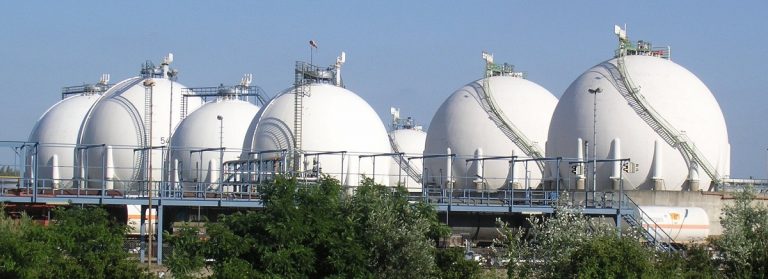
Hortonspheres, the trademarked name of giant containers for storing and transporting liquified natural gas (LNG), were invented by a bridge building company.
Chicago Bridge & Iron Company (CB&I) officially named “Hortonspheres” — also called Horton spheres — after Horace Ebenezer Horton (1843-1912), the company founder and designer of water towers and rounded storage vessels. His son George would patent designs standing among the great innovations to come to the oil patch.
Houston Ship Channel of 1914
The Houston Ship Channel, the “port that built a city,” opened for ocean-going vessels on November 10, 1914, making Texas home to a world-class commercial port. President Woodrow Wilson saluted the occasion from his desk in the White House by pushing an ivory button wired to a cannon in Houston.
Iowa 80 Trucking Museum
The Iowa 80 Trucking Museum in Walcott hosts an annual Jamboree and preserves more than 100 antique trucks. The museum’s collection began in 1979 thanks to founder Bill Moon’s unmatched passion for trucks. Every summer, the giant museum at exit 284 on I -80 outside Walcott hosts events for truckers, teachers, students – and transportation history buffs.
Remarkable Nellie Bly’s Oil Drum
Known as Nellie Bly, Elizabeth J. Cochran Seaman, investigated conditions at an infamous mental institution, made a trip around the world in less than 80 days — and manufactured the first practical 55-gallon oil drum.
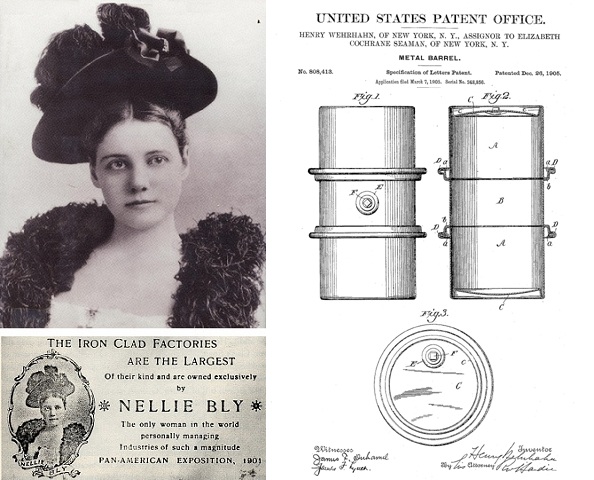
Recognizing the potential of an efficient metal barrel design, Nellie Bly acquired the 1905 patent rights from its inventor, Henry Wehrhahn, who worked at her Iron Clad Manufacturing Company.
The 1901 Pan-American Exposition in Buffalo, N.Y., promoted her Iron Clad Manufacturing Company as “owned exclusively by Nellie Bly – the only woman in the world personally managing industries of such magnitude.”
Trans-Alaska Pipeline History
The Trans-Alaska Pipeline System, designed and constructed to carry billions of barrels of North Slope oil to the port of Valdez, has been recognized as a landmark of engineering. On June 20, 1977, the 800-mile pipeline began carrying oil from Prudhoe Bay oilfields to the Port of Valdez at Prince William Sound. The oil began arriving 38 days later.
Kerosene Rocket Fuel
The 19th century lamp fuel that made the 1969 moon landing possible — and still powers rockets today (also see Petroleum Products).
The American Oil & Gas Historical Society (AOGHS) preserves U.S. petroleum history. Become an annual AOGHS supporting member. Help maintain this energy education website and expand historical research. For more information, contact bawells@aoghs.org. Copyright © 2024 Bruce A. Wells. All rights reserved.


